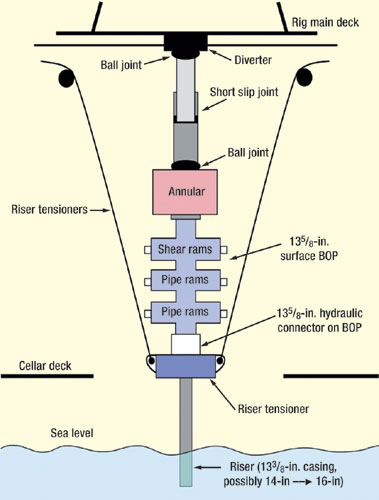|
Jan.
2002 Vol. 223 No. 1
Feature Article
|
DEEPWATER TECHNOLOGY
Surface BOPs: Background, implementation program
 hell
International E&P’s Graham Brander discussed: Shell’s exposure to use of these systems in the
calmer waters of Southeast Asia; basic designs of Surface BOPs (SBOPs) used by Shell; and the implementation
program planned for the U.S. Gulf on a 3rd-generation rig for 2002. hell
International E&P’s Graham Brander discussed: Shell’s exposure to use of these systems in the
calmer waters of Southeast Asia; basic designs of Surface BOPs (SBOPs) used by Shell; and the implementation
program planned for the U.S. Gulf on a 3rd-generation rig for 2002.
Background in Southeast Asia, benefits. In
mid-2000, Shell Indonesia participated in a two-well project using a SBOP system on Transocean’s
Sedco 601 semi. These two successes significantly increased interest in the system. Then, in mid-year
2001, the Shell operating unit in Brunei (BSP) used the semi for a three-well project using the frame-type
SBOP. And in the 3rd quarter of 2001, the Shell operating unit in Malaysia (SSB) used the Stena Clyde
semi for a two-well project using an alternative (unconstrained) SBOP system.
Results from these operations with mild metocean
conditions have produced data that allows this technology to be taken to other areas of the world. Principal
benefits from the use of SBOPs are that it:
- Potentially unlocks significant cost savings per
project by increasing the operating envelope of existing 3rd-generation rigs to that dominated by 4th and
5th-generation rigs. There is, therefore, the potential to reduce dayrates to $60,000 to $85,000, from
$145,000 to $200,000.
- Allows more efficient operations, i.e., no need to
run BOP to seabed.
Further, it potentially increases the number of
deepwater rigs available. And it increases the number of well projects that can be absorbed into a rig
sequence.
GOM designs, implementation. Fig. 1 illustrates
a laterally unconstrained SBOP design proposed for the Gulf of Mexico. There are several advantages of this
system over other surface BOP designs.
 |
|
Fig. 1. Laterally unconstrained surface
BOP design for Gulf of Mexico. |
|
Unlike other systems, it can be transferable between
rigs; i.e., using one system in an area can cut high rig mobilization costs. The system will include a subsea
shutoff and disconnect device that others do not have. And it will be designed for low-drilling-margin wells,
i.e., technically challenging wells.
Prelaid mooring packages will take advantage of
existing prelaid operational experience with one-boat preparation – the GOM will build on this. The
laterally unconstrained SBOP will be more tolerant of severe metocean conditions over the conventional fixed
design. A 16-in. riser capability will also be reviewed within the project’s work scope.
Shell is looking at implementation of an SBOP on a
3rd-generation rig by November 2002. This schedule will require contributions from several project packages
that are being addressed now. These include:
- Subsea shutoff / disconnect devices
- Riser analysis
- SBOP design options
- Mooring analysis
- Rig specifications, and
- Equipment / component specification / verification
guidelines.
Other related studies underway will define: 1) Safety
case philosophy and the well-control package; 2) risk-assessment / management tools; 3) performance-assurance
procedures; and 4) the SBOP management system.
While the Gulf of Mexico is the focus of SBOP
implementation, Shell operating units have commitments for 2002 and beyond for West Africa and Southeast Asia.
They are also studying future use for deepwater operations beyond 2002 off Brazil and in the Mediterranean
area. 

 |
Shell’s
deepwater program: A broad-based technology commitment |
 |
Don Jacobsen,
Manager, Drilling & Completions, Shell Exploration & Production Co. (SEPCo), New Orleans; |
 |
Paul Goodfellow,
Drilling & Completions Operations Manager, Shell International Exploration E&P Inc., New Orleans;
|
 |
Ken Dupal, Sr.
Staff Drilling Engineer, SEPCo, New Orleans; and |
 |
Graham Brander,
Sr. Drilling Engineer, Shell International E&P Inc., Houston. Overviews of their presentations follow.
 |
|



